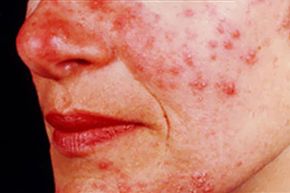If you don't know much about rosacea, you may think of it as a disease that simply gives people red faces, as if they're blushing all the time. Or, you might associate it with alcoholism, an image made famous by film actor W.C. Fields and his bulbous nose. The truth is that rosacea is a distressing condition that can have an intense impact on people who have it. And while W.C. Fields' trademark red nose was a complication of rosacea, it wasn't caused by alcoholism (although alcohol often makes rosacea worse).
Millions of people in the United States have the chronic skin disease rosacea (ro-ZAY-sha or ro-ZAY-she-ah) but don't know it. In fact, almost eight out of 10 Americans said in a Gallup poll that they don't know anything about the condition. Yet, to the more than 14 million people with rosacea in the United States, its effects can be significant, both physically and emotionally [source: National Rosacea Society].
Advertisement
Rosacea is an inflammatory skin condition that is sometimes mistaken for acne, sunburn, eczema or allergies. It affects more women than men, but women's cases are typically less severe than men's. People who blush easily are at risk of developing the disease. Age also matters: Rosacea is most often diagnosed in people between the ages of 30 and 60, and children are rarely diagnosed with it. Menopause ratchets up the risk factor. Rosacea seems to run in families, which makes sense when you know that being fair-skinned is also a risk factor [source: Mayo Clinic]. Fortunately, with proper treatment, rosacea can be controlled and its effects minimized or reversed.
Everyone who has rosacea has at least one of four primary symptoms, but there are other symptoms as well. Read on to learn more about what might cause your doctor to suspect you have rosacea, and find out which former U.S. president has the disease.
Advertisement

